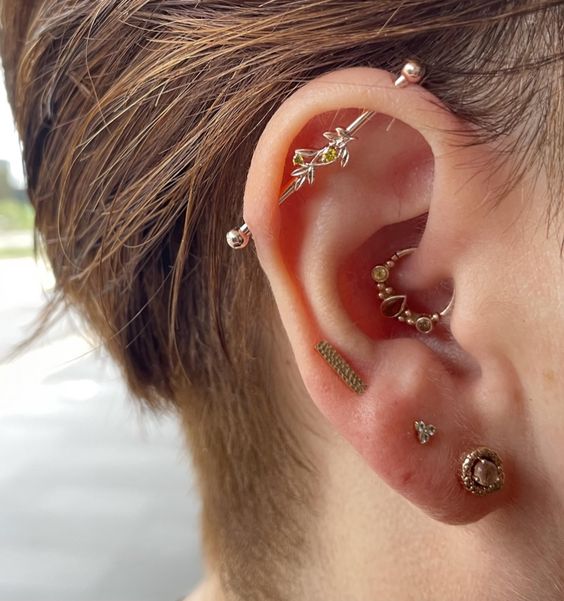You’ve likely come across helix piercings, those subtle adornments or bold statements gracefully situated toward the top of the ear.
Offering a simple way to refresh your appearance, helix piercings have become a trendy choice.
Whether you’ve been contemplating a helix piercing to complement your ear aesthetics or if this is your first encounter with the idea, especially given its popularity among celebrities like Lily Allen, Cardi B, and Miley Cyrus, we’ve got all the information you need.
In the following, discover the specifics of what a helix piercing entails and dispel any concerns about its perceived pain compared to other ear piercings.
Most importantly, delve into crucial aftercare practices to ensure a swift and smooth healing process.
What is a Helix Piercing?

Image Credit: Pinterest
According to Shannon Freed, a piercer at Studs, a helix piercing encompasses any piercing located along the upper and outer cartilage ridge of the ear.
While the term “helix” anatomically refers to that specific area of the ear, there are distinctive names for various placements along this curved structure.
Piercer Laura Bond further elaborates on these placements, highlighting the ‘flat helix’ as the flat area situated at the top of the ear just beneath the helix.
Additionally, she defines the ‘forward helix’ as the part of the helix nearest to the side of the face, positioned above the tragus where the ear connects to the head.
Despite its modest surface area, delicate studs or hoops placed in the forward helix are designed to face forward, thus earning its distinctive name.
What exactly is a double helix piercing?

Image Credit: Pinterest
Kevin Lamb, a piercer at Maria Tash, defines a double helix as two closely placed piercings that demand technical precision to achieve perfectly spaced placements.
He emphasizes the importance of executing the piercings with matching angles that not only complement each other but also harmonize with the chosen jewelry preferred by the client.
Now, addressing the burning question about helix piercing pain compared to lobes, Shannon Freed provides insights.
In straightforward terms, helix piercings generally tend to be more uncomfortable than lobe piercings due to the less fleshy nature of the helix.
The denser cartilage tissue requires more force to pierce through, resulting in a slightly elevated level of discomfort.
However, Freed reassures that the pain is temporary, and the end result – a stunning new piercing – is enduring.
Laura Bond further elaborates, mentioning that most individuals possess relatively thin cartilage around their helix, making it one of the less painful cartilage piercings.
At Laura Bond, they rate the pain level for helix piercings at approximately 5-6 out of 10.
What is the typical healing duration for a helix piercing?

Image Credit: Pinterest
According to Shannon Freed, the healing process is subjective and influenced by various factors such as overall health, sleep quality, stress levels, and adherence to aftercare practices.
As our bodies respond to and recover from physical stressors at varying rates, individual experiences may differ.
However, for a general estimate, Freed suggests a minimum of two months.
She elaborates that the initial healing period for a helix piercing typically spans two to four months.
Achieving full healing, where any discharge, swelling, redness, flaking, or soreness ceases, usually takes six to nine months.
It’s essential to recognize that healing timelines can vary based on the specific piercing and individual body responses.
The key indicator of complete healing is the absence of any signs of discomfort or irritation in the pierced area.
How to properly care for a helix piercing is crucial in preventing complications.
Shannon Freed emphasizes the importance of hands-off policy for a fresh piercing, advising against touching or twisting it.
Instead, she recommends spraying saline solution on both the front and back of the piercing, limiting it to no more than twice a day.
Caution is advised to avoid snags and sleeping on the piercing, as such actions can disrupt the healing process.
When it comes to cleaning, sticking to a saline solution is vital.
Piercers often provide a saline spray for home use, with NeilMed being a recommended choice by the experts we consulted.
The salt in the solution aids in pulling out excess discharge while promoting blood circulation.
It is crucial to steer clear of rubbing alcohol, hydrogen peroxide, or ointments, as they can dry out and further irritate the piercing, potentially extending the overall healing time.
Additionally, Beizsley stresses the importance of drying the ear after applying the saline solution.
Gently dabbing it with a piece of dry, non-woven gauze or kitchen paper is recommended.
Beizsley explains that a warm and moist new wound can be a breeding ground for bacteria, making thorough drying essential.
Even using a warm hairdryer is suggested, but ensuring the piercing is clean is crucial to avoid driving bacteria further into the wound.
A Dyson is considered the most hygienic option if available.
How to manage sleeping with a helix piercing?
Kevin Lamb humorously suggests the standing-up approach, but in all seriousness, he recommends using a travel pillow – the kind worn around the neck during flights.
To ensure optimal comfort for your ear, he advises placing it in the center of the pillow hole.
Additionally, Lamb suggests washing the pillow beforehand, particularly if used during travel when maintaining sanitation can be challenging.
While sleeping on the other side or on your back is an option, Lamb acknowledges that breaking the habit might be challenging.
What Should You Do About An Infected Helix Piercing?
Addressing concerns about an infected helix piercing, Shannon Freed differentiates between irritation and infection, emphasizing that with proper aftercare, severe infection is less likely.
It’s normal to experience slight bleeding, crusties (dead skin cells), swelling, tenderness, itching, bruising, or soreness, and these symptoms typically subside within a few weeks.
However, if any symptoms persist or worsen, Freed advises seeking advice from a doctor.
Laura Bond underscores the importance of following good aftercare practices, including avoiding sleeping on the piercing, changing your pillowcase regularly, refraining from swimming for the first month after the piercing, and ensuring the piercing stays dry after cleaning.
Additionally, she warns against the temptation to change jewelry before the piercing is fully healed.
What occurs if your body rejects a helix piercing?
According to Beizsley, while most people can accommodate some form of helix piercing, a forward helix is particularly dependent on anatomy.
If an individual lacks a sufficiently large area in that specific region, there’s a risk of migration, where the piercing could grow out of the cartilage.
Kevin Lamb notes that while it’s rare for a helix piercing to experience rejection, common irritants include accidental knocks, sleeping on it, or prolonged pressure, such as from wearing riding helmets.










